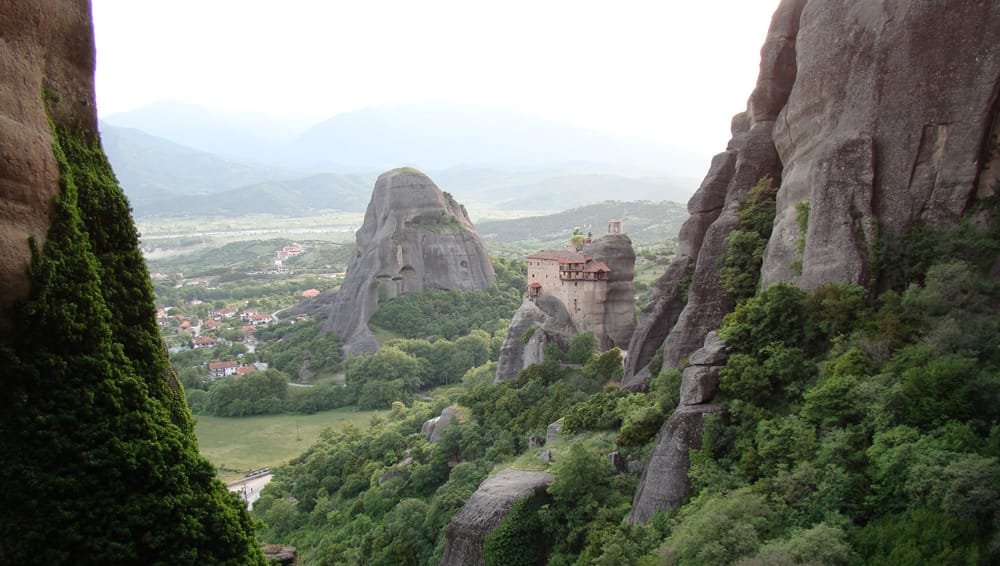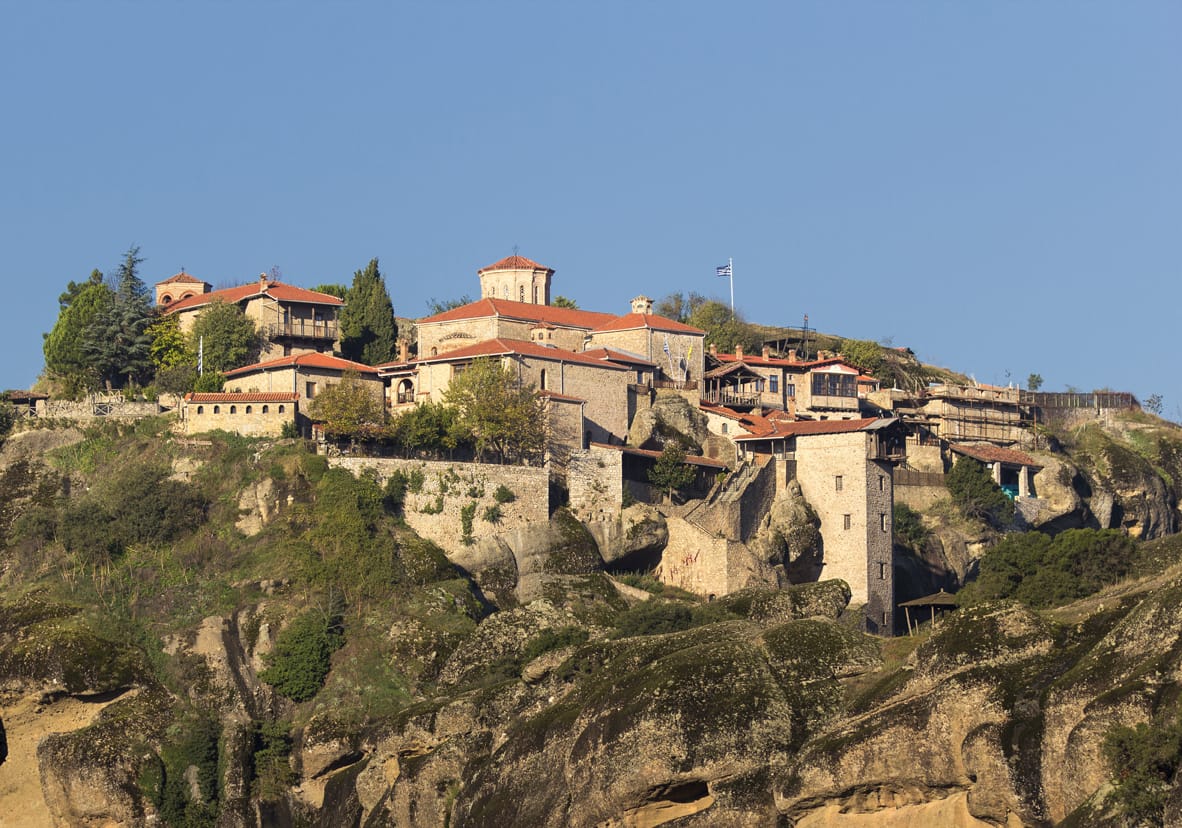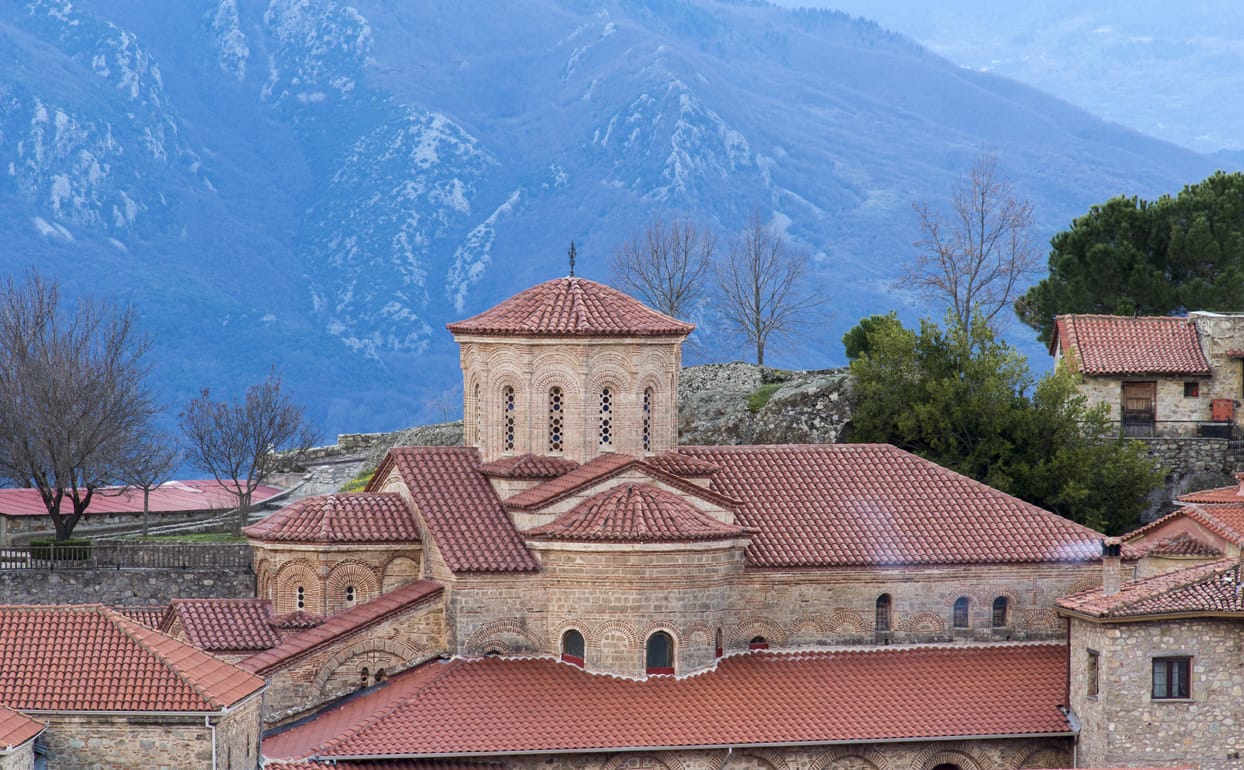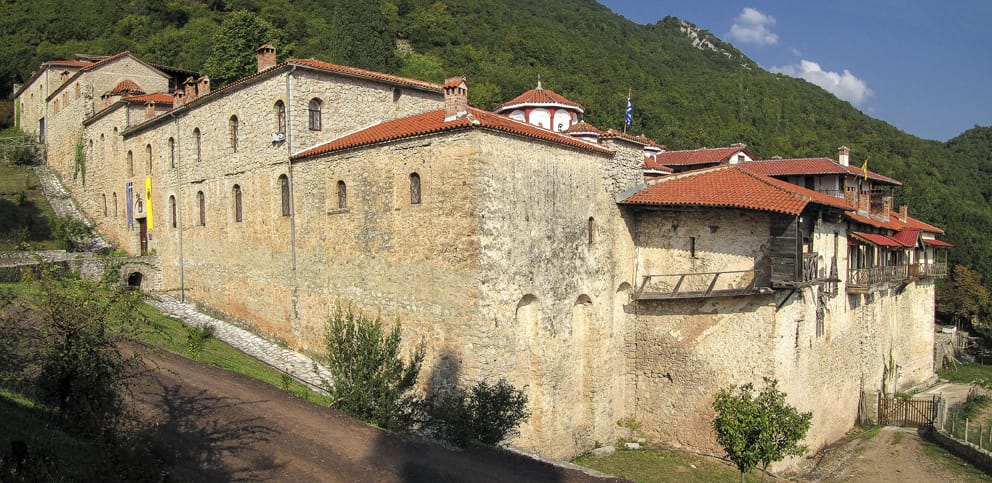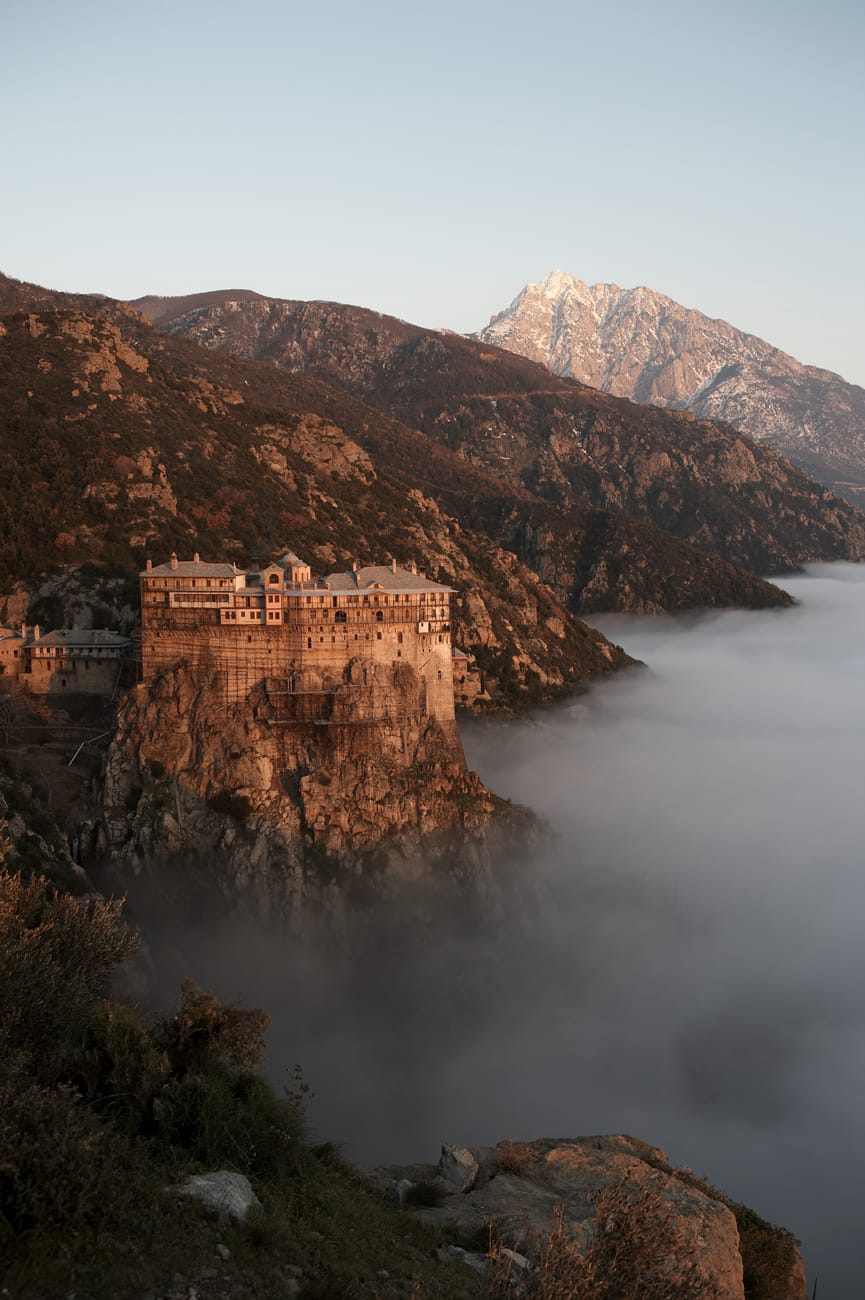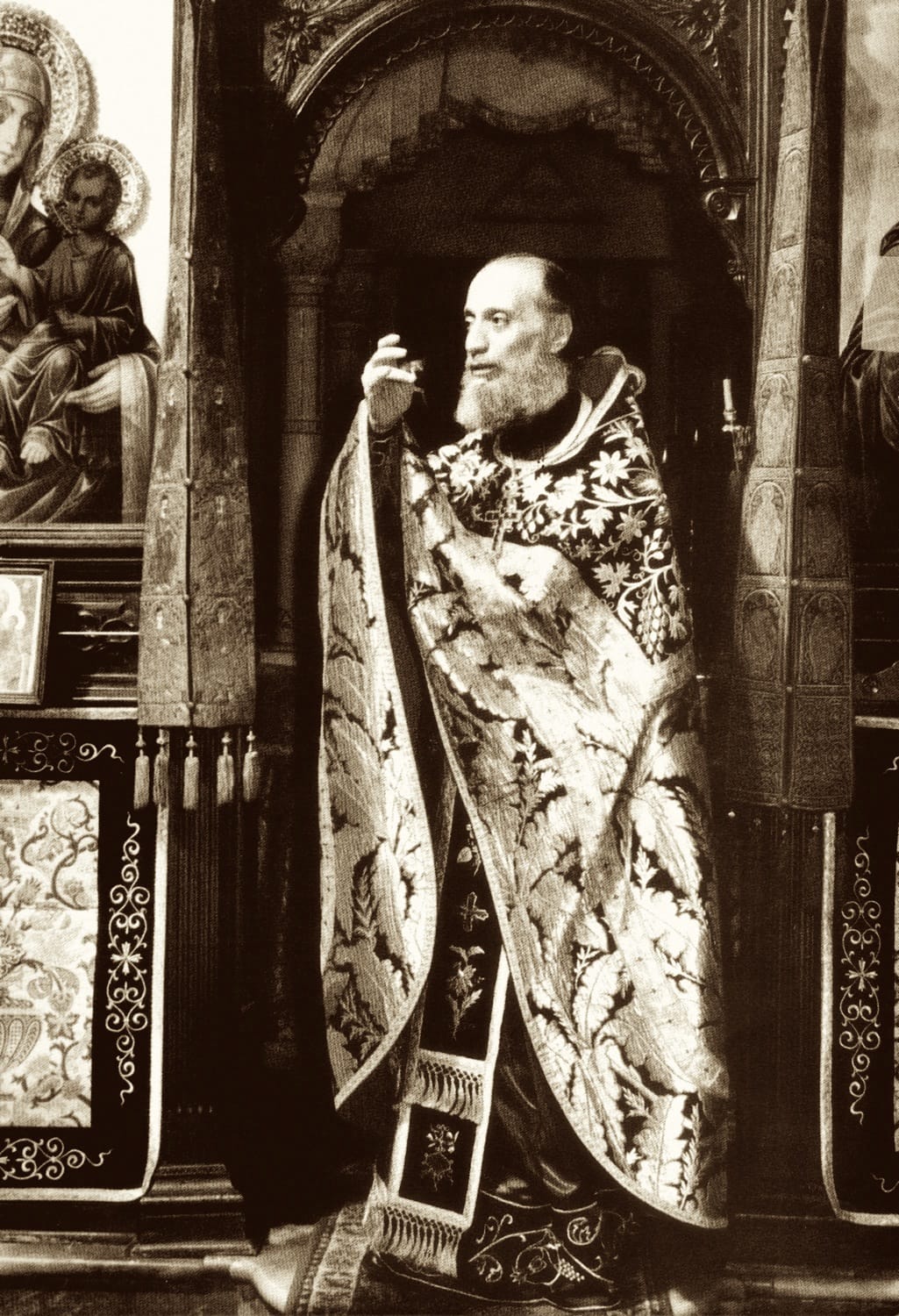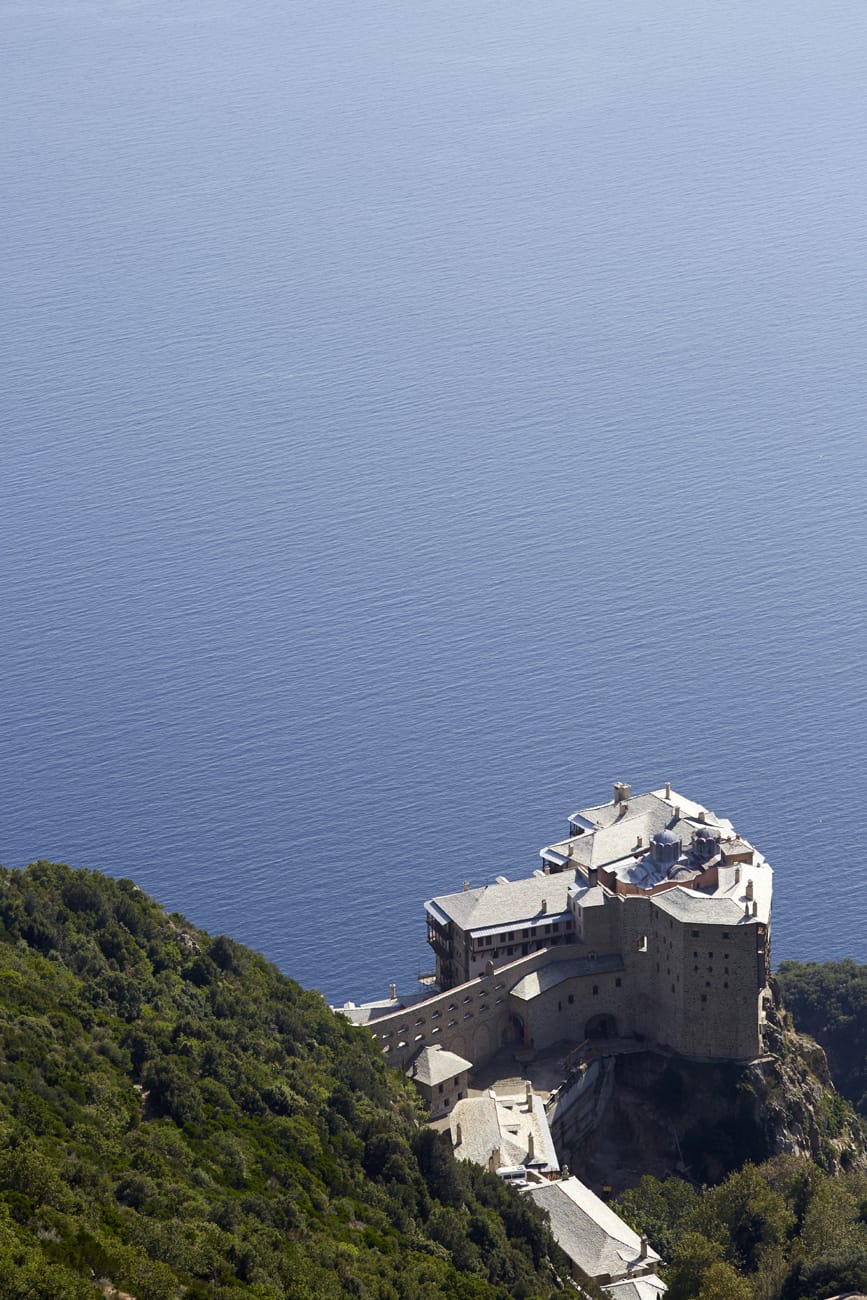Elder Aimilianos
TRACING A LIFE (Revised Edition 2025)
(First version by Hieromonk Serapion of Simonopetra,
SYNAXIS EUCHARISTIAS – A tribute in honor of Elder Aimilianos, Indictos 2003.)
Archimandrite Elder Aimilianos, born Alexandros Vafeidis, was abbot of the Holy Monastery of Simonopetra of Mount Athos from 1973 to 2000, and founder of the Holy Convent of the Annunciation in Ormylia, Halkidiki. He was born in 1934, to pious parents, in Nikaia, Piraeus. The family originated from Asia Minor: His paternal grandmother, Evdoxia, was from Constantinople, and his grandfather, Alexandros, from Selymbria (present-day Silivri), in Thrace, and studied at the famous Theological Seminary of Chalki Island (present-day Gökçeada).
In 1906 his grandparents moved to Semantra, in Cappadocia, where they served as teachers for the Greek community. They came to Greece after the Greco-Turkish War/Asia Minor Massacre (1919–1922) with the population exchange. Although married, they lived like monastics in prayer and abstinence. It should be noted that both the Elder’s grandmother and mother became nuns and died as sister Evdoxia and sister Aimilani, respectively.
Elder Aimilianos attended primary school at Semantra, Halkidiki, where his grandmother had settled and taught. For secondary school he moved to Nikaia, in Piraeus, where his parents lived; he was always an excellent student. He continued his studies at the University of Athens; he initially attended Law School for one year and then continued with Theology, following the inclination of his heart.
During his university studies, together with a group of like-minded friends from his high school years, the Elder was extremely active in organising Sunday schools, church camps, speeches and various events, which revealed and cultivated his inter-personal, spiritual, leadership and organisational gifts. When he completed his studies, due to the education and training offered at the time, he considered becoming a priest so that he could go on to become a missionary abroad. However, he thought it would be best to start his preparation for such a ministry at a monastery. He approached the then Metropolitan of Trikki (present-day Trikala) and Stages, Dionysios, who had just undertaken his episcopal duties and was known as a bishop who supported monasticism.
Thus, the Elder arrived at Trikala in 1960 and placed his future in the Metropolitan’s hands, who on 9th December 1960 tonsured him a monk at the Varlaam Monastery of Meteora and was given the name Aimilianos. On the 11th of the same month, the most reverend Metropolitan ordained him a deacon at the church of St. Paraskevi in Trikala, and on 15th August 1961 ordained him a priest at the Holy Monastery of Vytouma.
Once a priest, he was moved to the Monastery of St. Vessarion (Dousikou) where he stayed until November 1962. At that remote, isolated, yet blessed place, he lived alone and in silence, painfully and extensively crying out and seeking God, who redeems from storms and saves failing spirit. The Lord, in His providence, listened to Elder Aimilianos’ hidden cries, revealing Himself to his servant, transforming his existence by His light. God revealed to the Elder the path he should follow in life. Now with new zeal and desire for the monastic life, he envisions with insurmountable courage and soaring hope to revive and renovate the monastic life there. He directed all his effort and God-given enlightenment towards transforming the existing monastery relics into new spiritually fruitful communities.
At the end of 1961, given that the Metropolitan of Trikki shared the same dedication for the monastic life, transferred Elder Aimilianos from St. Vessarion to the Transfiguration Monastery of the Great Meteoron, making his the Abbot. It was there, all alone at first, where, despite his fragile health, the Elder indefatigably cultivated with great patience and perseverance, a life of asceticism, mystical and hidden. He kept vigil throughout the night, prayed continuously and delved into unceasing studying of paternal, ascetic and ecclesiastical works. His unquenchable thirst led him to seek, find and investigate every text referring to the organisation and operation of Eastern Orthodox monastic life, particularly that of a coenobium, thoroughly exploring the monastic institutions of the Eastern Orthodox Church and the Typikon [Rubric] of distinguished ancient monasteries.
While Elder Aimilianos led a purely ascetic life, on 16th February 1963, the Metropolitan bestowed on him the title of Archimandrite and assigned him the ministerial task of preaching the word of God and hearing confessions. In addition, he also educated the youth in his province, and was appointed in charge of the church of Panagia Episkepseos in Trikala.
This opened a new chapter in the life of the reverend Elder. He was not alone anymore; he became a ‘father’ to numerous ‘sons and daughters of God’. He lived and felt like a true apostle. His life was dedicated to his children in full freedom, without any expectations even to the end for even the slightest reciprocation or response. Many of these spiritual children considered the monastic life, and in time, the initial nucleus of the brotherhood of the Monastery of Meteoron was created. Others turned to the priestly or family life; whatever their choice, all lived as one extended spiritual family centred around the monastery.
In 1963 the first two monks settled at Megalo Meteoron; and from the 1965-66 school year, numerous secondary school pupils conducted themselves as novices, trying out the monastic life next to the Elder. On 6th August 1966 Elder Aimilianos was tonsured a Great Schema monk by Metropolitan Dionysios, his own Elder. The course of the young, gifted Elder’s life—now as abbot of the flourishing Great Meteoron Monastery—brought a noticeable brightness to the reverend Metropolitan and filled him with hope for the future.
When monastic life was being established at Meteora, Elder Aimilianos consulted and forged spiritual bonds with various holy fathers and contemporaries, such as: Athanasios Hamakiotis, Dimitris Gagastathis, Amphilochios of Patmos, Philotheos Zervakos, Simon Arvanitis, Damaskinos Katrakoulis. During the same period, Elder Aimilianos also forged bonds with eminent members of the Serbian clergy, Athanasios Yevtich and Amfilohie Radovic, then students at the University of Athens. They were both spiritual children of the holy Elder and pillar of the Serbian Church, Saint Justin Popović—whom Elder Aimilianos visited in Serbia (1976) after having become the Abbot of Simonopetra Monastery.
At the same time, the Elder launched his pilgrimage trips to Mount Athos, where he collected a wealth of spiritual experience. It was then that Elder Aimilianos became acquainted with the holy Elder, now Saint Paisios. On reaching the far end of the peninsula, at Katounakia, he met the champion of obedience, Saint Ephraim of Katounakia. The two great Elders formed a strong spiritual relationship, for which Saint Ephraim often said: “I found my late Elder, another Elder Joseph, the golden-tongued and reverend, Elder Aimilianos.”
In 1968, after the tonsure of three monks at the Meteoron brotherhood, with deep thought—or, rather, foresight—the Elder laid the foundations of coenobitic life. His insight and foresight immediately led him to select as his successor the then secondary school pupil, Emmanuel Raptis, present-day Abbot of out holy Monastery, the very reverend Archimandrite Elissaios. In 1972, after a long trying period of difficulties, the initial nucleus of the monastic sisterhood was also ready, led by its present-day Mother Superior, Abbess Nicodeme. They temporarily stayed at the Monastery of the two St. Theodores, near Meteora. While the sisterhood was still in its early days, the wise Elder prepared its internal Regulation, a written text which constitutes his spiritual will. The Elder presented to the sisters this ‘testament’ of coenobitic, monastic life on 5th May 1975, when they finally settled at the Dependency of the Annunciation in Ormylia, Halkidiki.
Following the unexpected repose of the late Metropolitan Dionysios in January 1970, the brotherhood of the Great Meteoron sought a quieter and more suitable monastic location. At this time, the last remaining elderly monks of Simonopetra Monastery sent a pleading request for the brotherhood to hear their prayers and continue their monastic life on Mount Athos. At the end of 1973, the Meteoron brotherhood was ‘transplanted’ to Mount Athos. The Abbot’s office had remained vacant, following the late Archimandrite Charalambos’ repose, until25th November 1973 when Elder Aimilianos was formally elected by the senior, already existingfathers of the Monastery—in accordance with the Athonite tradition. His enthronement followed on 17th December by the Holy Community of Mount Athos.
As abbot, the reverend Elder was equally dedicated to his personal prayer life, to serving the Divine Liturgy and all his other duties, as well as undertaking the reorganisation of the internal life of the new brotherhood. He embraced the existing Typikon of Mount Athos with wisdom and discernment. Additionally, he placed his own personal imprint on monasticism and the spiritual life, in line with the divine canons compiled by the holy Fathers—whom he so adored and studied with zeal. Throughout his ministry the Elder devoted many talks and catechetical speeches on the writings of the Fathers of the Church and delivered them to a contemporary audience in a unique and timeless way.
Elder Aimilianos had great respect and love for the older monks and infused their experience with the youthful enthusiasm, dedication and zeal of the younger monks to form a united, significantly larger, new brotherhood. With his virtuous administration and his pastoral ministerial care, he restored the prestige and long tradition of this century-old Monastery.
While his brotherhood settled at Mount Athos, his fatherly concern was also to find a monastic settlement for the growing sisterhood. Simonopetra Monastery, with the approval of the local bishop and the support of the Holy Community, bought the old Vatopedi Dependency of the Annunciation in Ormylia. On 5th July 1974 the Convent was established and has been operating ever since as a Dependency of Simonopetra.
Great effort and deep prayer were necessary to renovate this small, dilapidated dependency, of which the Elder became the wise and magnanimous founder. He had to start from nothing, in every respect. Having ensured the necessary peace and quiet in the area surrounding the Dependency, in 1980 he launched the reconstruction of the buildings, “with God’s good will and grace,” as well as the contribution of the faithful. The result was the creation of this largeCoenobium within fifteen years. Elder Aimilianos was filled with spiritual joy and deeply moved when the Katholikon of the Dependency was founded, on 14th September 1980, by Metropolitan Synesios of Kassandreia, in whose respectful person he encountered the discerning and judicious bishop. On 25th October 1991, the Dependency received Patriarchical and Stavropegial recognition, by virtue of an Epistle bearing the Partriarchal sigillum of his All Holiness Ecumenical Patriarch Bartholomew.
Following the example of the Saints and Fathers of the Church, who helped the sick and those in need, in 1982, Elder Aimilianos founded the spiritual, medical and social support Centre ‘Panagia Philanthropini.’ The centre is near the Dependency and the legacy of the late Captain Ioannis Hatzipateras and operates under the care of the sisterhood, as a humble, selfless offering to the people of the vicinity.
The Elder considered all of the Dependencies as part of Simonopetra Monastery, namely: The church of the Ascension in Athens, the church of St. Haralambos in Thessaloniki, the Monastery of St. Nicodemos in Pentalofos, Goumenissa, and in France the Monastery of St. Antoniοs and the two Convents, namely of the Transfiguration and of the Holy Protection (Agia Skepi). Elder Aimilianos looked after and supported all of them with fatherly devotion, tenderness and care, as there many gathered and found the support and comfort of the Church.
He showed special care and concern for those of other faiths who sought his guidance and was involved in the catechism of many of them, whom he later baptised and tonsured. Notable among them are Archimandrite Placide Deseille and Father Elias Ragot, with their monastic entourages. From 1979-1984, these brotherhoodswere created and formed the three Simonopetra dependencies in France, as mentioned above, under the guidance and with the support of the Elder. These monasteries are centers of Eastern Orthodox monasticism in the West.As of 1980, Elder Aimilianos often visited the Dependencies in France to guide and strengthen the new brotherhood and sisterhoods.
During these years, the Elder encountered and bonded spiritually with Saint Sophrony at the Monastery of St. John the Baptist in Essex, England. The two Elders had a deep spiritual relationship. In fact, in 1988, the Elder attended the ceremonies of the canonisation of St. Silouan the Athonite and the opening of the church dedicated to the Saint. While in 1993, shortly before Father Sophrony’s repose, Elder Aimilianos accepted his invitation to bless his final abode in the newly constructed crypt.
As abbot, Elder Aimilianos participated in Mount Athos affairs, the meetings of its supreme institutional bodies, namely, the Biannual Holy Assembly and the Extraordinary Double Holy Assembly. With his discernment and experience, the Elder contributed willingly and successfully in discussions and provided solutions to various athonite matters. He also represented Mount Athos many times before the Ecumenical Patriarchate, the Hellenic Republic and elsewhere, as a member of Holy Community Committees and as a mission delegate [exarchos].
Most of all, the Elder deeply sought isolation, silence and ascesis within the monastic life. Although, as the spiritual father of Simonopetra Monastery and Ormylia Dependency he dedicate much of his time to teaching the monastic life. His love for God’s people and the Church also led him to accept invitations by bishops, clergy or other bodies, to deliver talks at various locations or to participate in theological-monastic conferences in Greece, Cyprus and elsewhere, for the edification of his brothers and sisters in Christ.
Placing the Lord always before him, he faced all difficulties in the most natural, calm and joyful manner, accepting everything as a divine blessing. With this disposition he also accepted the major fire of August 1990, which burnt major parts of Mount Athos and seriously threatened Simonopetra Monastery.
In the beginning of 1995, his health permanently declined, obliging the reverend Elder to gradually withdraw from his duties as abbot and leave the monastery he so cherished and his beloved Mount Athos. Elder Aimilianos withdrew to the Ormylia Dependency, patiently suffering in his “flesh what is lacking in the afflictions of Christ, for the sake of His body, which the Church” (Col. 1:24). In 2000, Elder Aimilianos handed over the staff of his abbacy to the present-day Abbot of Simonopetra, the Elder Elissaios, who continues until now the work of Elder Aimilianos in filial respect.
On 9th May 2019, Elder Aimilianos reposed in the Lord, at the Dependency of Ormylia. His relics lie in the founder’s tomb, in the external narthex of the Katholikon of the Dependency. Engraved on his tomb is the psalm verse, “O God, You are my God; early will I seek you” (Ps. 63:1), characterising his whole life of prayer and vigil.
From the spiritual wealth of the Elder, very few texts were published during his active years, since his main mission was to edify his spiritual children or the congregation to help them grow in spirit, and thus humbly avoidedwriting. Although, for the benefit of all, the sisterhood of Ormylia Monastery has undertaken to transcribe the plethora of catechisms and talks by the Elder, and publishes them as a form of pastoral love to the Church of God.
The teaching of Elder Aimilianos are characterised by an experiential approach to any theme, by deep analysis of concepts and a spontaneous, ever-flowing manner of expression. His catechism talks are the precious legacy and spiritual inheritance bequeathed to his monastics. Like a chalice full of “undiluted wine” (Rev. 14:10), which, in hisenduring silencehas become “adorned with gold and silver” (Ezek. 16:13) and preserved by the brotherhood and sisterhood as a precious heirloom.
The Elder’s time as abbot of Simonopetra has already been recognised as one of the most blessed periods of the modern history of the Monastery, making it duly proud, and, by the blessing of the Theotokos, coincides with the rise in monks generally on Athos and with the beaming light of the Holy Mountain. As the Elder himself says:
“the monastic sodality of the Coenobium, living at its own pace,
in essence lives within and for the Church, as the heart or an extremity is for the body.
This community is not appreciated for works or activities,
but, mainly, for its active yearning for God.
This is how monks become God-like, attracting others to the divine life”
(Typikon of the Holy Convent of Ormylia).
